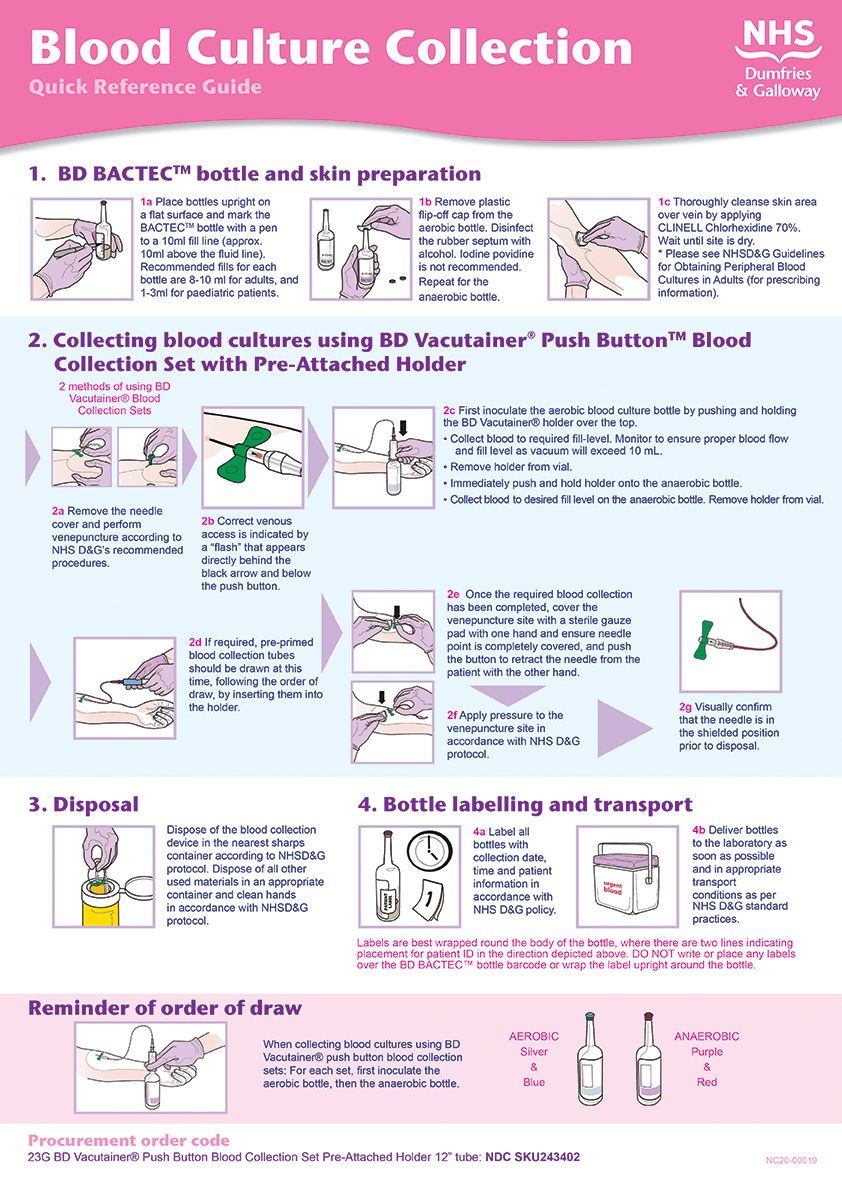In this section : Infectious Diseases
Treatment of Malaria
Gentamicin Prescribing (Paediatrics)
Influenza A
HIV Testing Guidelines
Clostridiodes difficile Infection
Blood Culture
OPAT SBAR (Complex Infections)
Staphylococcus aureus Bacteraemia (SAB)
Neutropenic Sepsis
Antibiotics and the Kidney
Acute Diarrhoea
Suspected Meningitis
Suspected Sepsis
Gentamicin Dosing
Urinary Tract Infection
Vancomycin Dosing
Cellulitis
Post Splenectomy Sepsis
Home | Articles | Infectious Diseases |
Blood Culture
Last updated 30th July 2021
Blood culture is the gold standard for diagnosing septicaemia and is an integral part of the Sepsis 6 bundle. They provide clinicians and microbiologists with the information they need to progress to targeted antibiotic therapy.
Indications
- Abnormal core temperature <36°C or >38°C
- Focal signs of infection
- Tachycardia (>90), blood pressure (low or raised), elevated respiratory rate (>20)
- Chills/rigors
- Abnormal white cell count (<4 or >12)
- New or worsening confusion
- Severe Inflammatory Response Syndrome (SIRS) – two or more criteria met
- NB Only take blood cultures when there is a clinical indication to do so and not as routine.
Timing
- Blood cultures should be taken at the earliest possible time following clinical suspicion of sepsis.
- If you are collecting other samples, collect blood cultures first
- Blood cultures should always be obtained before administration of antibiotic therapy but without unduly delaying treatment in emergencies.
- Specimens can still be collected after antibiotics have been commenced but this reduces the probability of identifying the causative organism.
Skin Asepsis and Technique
- Aseptic collection of blood from the patient is imperative to avoid contamination of the specimens with skin flora.
- NHS D&G have introduced a new system for blood culture collection using the BD Vacutainer® Push Button™ Safer Butterfly Blood Collection Set with Pre-Attached Holder.
- Ideally cultures should not be taken from a peripheral venous cannula, even if newly inserted but it is understandably difficult in emergency scenarios. In these cases, please take a second set of cultures as soon as a peripheral stab is possible
- Avoid venepuncture from:
- the upper limb on the same side as a previous mastectomy
- fistulas
- infected/excoriated skin
- a vein immediately above a peripheral cannula
- Take two sets of cultures, always making a fresh stab for each specimen – the interval between cultures does not have significant influence.
- In suspected endocarditis, a minimum of three sets (native valve) or up to 6 sets (prosthetic valve) should be collected over 24 hours or over 1 hour if critically unwell. Please make separate stabs for each set.
Central Venous Catheters
- Take one set of cultures from the line plus a separate peripheral stab.
- In the absence of a suitable peripheral venous site, an arterial blood site can be considered a valid alternative, because arterial blood has been shown to perform similar to venous blood in terms of contamination and sensitivity.
- Cultures from each lumen are not necessary in the case of a CVC
Hickman Line
- Take one set of cultures from each lumen, labelled appropriately along with a peripheral sample.
Blood Culture Collection Video
Links
- NHSD&G Blood Culture Collection Information [pdf]
- Riedel, S., Bourbeau, P., Swartz, B., Brecher, S., Carroll, K. C., Stamper, P. D., … Doern, G. V. (2008). Timing of Specimen Collection for Blood Cultures from Febrile Patients with Bacteremia. Journal of Clinical Microbiology, 46(4), 1381 LP – 1385. https://doi.org/10.1128/JCM.02033-07
- Lamy, B., Dargère, S., Arendrup, M. C., Parienti, J.-J., & Tattevin, P. (2016). How to Optimize the Use of Blood Cultures for the Diagnosis of Bloodstream Infections? A State-of-the Art. Frontiers in Microbiology, 7, 697. https://doi.org/10.3389/fmicb.2016.00697
- Miller, J. M., Binnicker, M. J., Campbell, S., Carroll, K. C., Chapin, K. C., Gilligan, P. H., … Yao, J. D. (2018). A Guide to Utilization of the Microbiology Laboratory for Diagnosis of Infectious Diseases: 2018 Update by the Infectious Diseases Society of America and the American Society for Microbiologya. Clinical Infectious Diseases, 67(6), e1–e94. https://doi.org/10.1093/cid/ciy381
- Stohl, S., Benenson, S., Sviri, S., Avidan, A., Block, C., Sprung, C. L., & Levin, P. D. (2011). Blood Cultures at Central Line Insertion in the Intensive Care Unit: Comparison with Peripheral Venipuncture. Journal of Clinical Microbiology, 49(7), 2398 LP – 2403. https://doi.org/10.1128/JCM.02546-10

